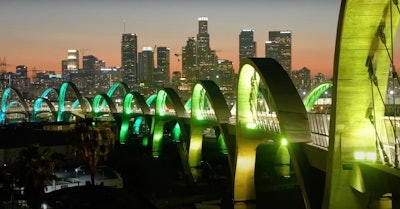
The new Sixth Street Viaduct project in Los Angeles has won the top national award from the American Council of Engineering Companies as the most outstanding engineering achievement for 2023.
The 3,500-foot-long bridge spanning the L.A. River features 10 pairs of 30- to 60-foot concrete arches and is the largest bridge project in the city’s history. The bridge is also believed to be the longest seismically isolated tied-arch concrete bridge in the world. It required 100,000 tons of concrete and 8,250 tons of steel. It also features wider walkways and separate bike lanes. A 12-acre public park is being built beneath it.
The $588 million bridge replaces the famous viaduct built in 1932, which was demolished in 2016 because of deterioration. It was a scene location in many films.
The new bridge is known in the city as the “Ribbon of Light” as the arches are lighted at night. It connects the historic Boyle Heights to the Downtown Arts District.
 Seismic isolation bearing at the base of a vertical support column.American Council of Engineering Companies
Seismic isolation bearing at the base of a vertical support column.American Council of Engineering Companies
Columns are fitted with triple friction pendulum bearings that allow for 36-inch lateral sway in either direction. Each viaduct piling extends 165 feet underground.
Each arch required 12 to 14 hours of continuous concrete pouring. Beneath the arches are concrete “Y-Bents” designed to flow seamlessly into the arches.
The bridge was designed by architect Michael Matzan. HNTB of Los Angeles was the viaduct’s prime consultant leading the design team. Contractors were the CMGC joint venture of Skanska and Stacy and Witbeck.
 A rendering of a 12-acre park being built beneath the viaduct.American Council of Engineering Companies
A rendering of a 12-acre park being built beneath the viaduct.American Council of Engineering Companies











